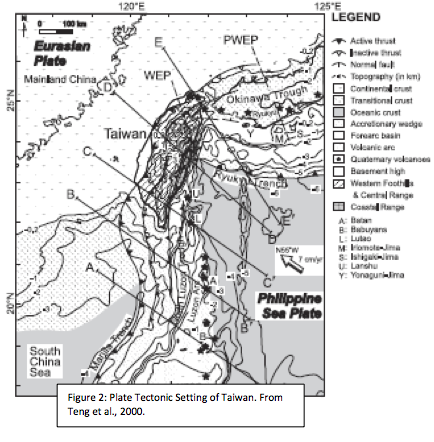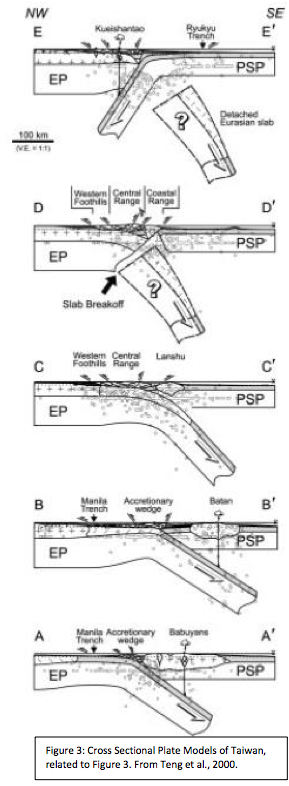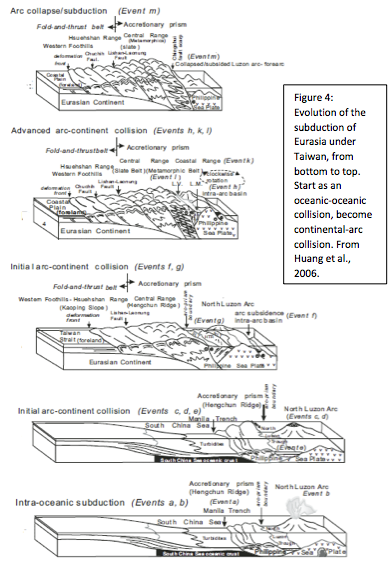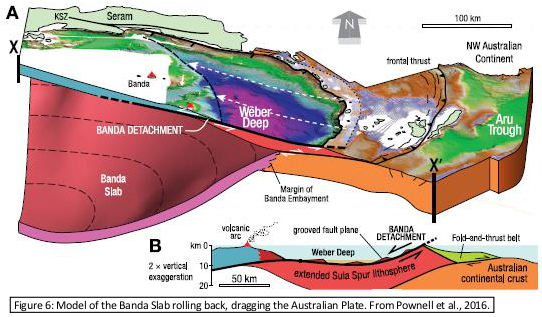H: North America was subducted under Rubia
Are there modern analogs of subduction of a continent under something like Rubia?
Rhianna Henry
Original pdf version
 In the Geological Society of America Special Papers “Did Westward Subduction Cause Cretaceous–Tertiary Orogeny in the North American Cordillera?” and “Mesozoic Assembly of the North American Cordillera” by Robert S. Hildebrand, the author argues that the North American continent experienced westward subduction under what he calls a “ribbon continent” known as Rubia around ~124Ma. This ribbon
continent is composed of multiple terranes
both known to be exotic to North America,
and terranes that were previously thought to
be part of North America. As the seaway
between Rubia and North America closed,
Hildebrand postulates that North America was
dragged underneath with the oceanic crust.
This continental material combined with the
fluids from the margin caused great amounts
of magmatism in the North American
Cordillera. Eventually the continental crust
broke due to upward buoyancy. This caused
slab failure around 75-60 Ma, followed by a
reversal of subduction polarity around 53 Ma,
with eastward subduction through the mid-Tertiary (Fig. 1).
In the Geological Society of America Special Papers “Did Westward Subduction Cause Cretaceous–Tertiary Orogeny in the North American Cordillera?” and “Mesozoic Assembly of the North American Cordillera” by Robert S. Hildebrand, the author argues that the North American continent experienced westward subduction under what he calls a “ribbon continent” known as Rubia around ~124Ma. This ribbon
continent is composed of multiple terranes
both known to be exotic to North America,
and terranes that were previously thought to
be part of North America. As the seaway
between Rubia and North America closed,
Hildebrand postulates that North America was
dragged underneath with the oceanic crust.
This continental material combined with the
fluids from the margin caused great amounts
of magmatism in the North American
Cordillera. Eventually the continental crust
broke due to upward buoyancy. This caused
slab failure around 75-60 Ma, followed by a
reversal of subduction polarity around 53 Ma,
with eastward subduction through the mid-Tertiary (Fig. 1).
As a way of checking to see if this hypothesis is plausible, I investigated modern geologic settings that are undergoing similar tectonic events. Although these regions are not perfect analogies, they share enough tectonic features that Hildebrand’s model appears somewhat less outlandish. Taiwan, New Guinea and Indonesia, and the Himalayas are the areas of interest. Taiwan is a modern example of continental crust getting subducted along a trench, but experiencing a break and subduction polarity reversal under an oceanic arc. The Luzon Trench and the Ryukyu Trenches are opposite in subduction direction in Taiwan, relative to the motion of the Philippines Sea Plate and the Eurasian Plate. New Guinea and Indonesia have regions where there are deep trenches and subduction of continental crust underneath an oceanic plate, especially for the Banda Slab and Weber Deep. The Himalayas are a well-known continent-continent collision zone, where the Indian plate is subducting underneath the Eurasian plate in Tibet.
In Taiwan, the Philippine Sea Plate is moving to the north-east, colliding with the Eurasian plate. The continental Eurasian plate is subducting eastward underneath the Phillipine Sea Plate at the Luzon Trench. The resulting magmatism created the island of Taiwan, east of the South China Sea.  According to Teng et al,. 2000, the region is not only experiencing uplift from the subduction of the Eurasian continent under the Philippine Sea Plate at the Luzon Trench, but to the north, it is experiencing orogenic collapse as the subduction polarity is reversed at the Ryukyu Trench (Figure 2). Slab break-off is invoked as the dominant mechanism driving the reversal; the Eurasian plate breaks, as it can no longer subduct underneath an oceanic plate (Figure 3). At the north edge of this margin, striking roughly east-west, instead the Philippine Sea Plate subducts underneath the Eurasian plate. Between the Luzon and Ryukyu Trenches there must be a tear in the plates around line D – D’ in Figure 2, 3. Over time, this tear could eventually propagate the polarity shift until it is fully the Philippine Sea Plate subducting underneath Eurasia across the Taiwan region. The mechanism for Taiwan’s volcanism due to subducted continental material is similar to what Hildebrand suggests, as is the regionally and temporally shifting slab break-off and subsequent polarity reversal. Huang et al., 2006 models the accretionary prism of Taiwan, magmatism creating the island, and fold and thrust belts over time, (Figure 4), which show remarkable likeness to Hildebrand’s hypothesized collision between Rubia and North America. The collision would have evolved from edges of oceanic margins to continental, in both situations, becoming a continental-arc collision.
According to Teng et al,. 2000, the region is not only experiencing uplift from the subduction of the Eurasian continent under the Philippine Sea Plate at the Luzon Trench, but to the north, it is experiencing orogenic collapse as the subduction polarity is reversed at the Ryukyu Trench (Figure 2). Slab break-off is invoked as the dominant mechanism driving the reversal; the Eurasian plate breaks, as it can no longer subduct underneath an oceanic plate (Figure 3). At the north edge of this margin, striking roughly east-west, instead the Philippine Sea Plate subducts underneath the Eurasian plate. Between the Luzon and Ryukyu Trenches there must be a tear in the plates around line D – D’ in Figure 2, 3. Over time, this tear could eventually propagate the polarity shift until it is fully the Philippine Sea Plate subducting underneath Eurasia across the Taiwan region. The mechanism for Taiwan’s volcanism due to subducted continental material is similar to what Hildebrand suggests, as is the regionally and temporally shifting slab break-off and subsequent polarity reversal. Huang et al., 2006 models the accretionary prism of Taiwan, magmatism creating the island, and fold and thrust belts over time, (Figure 4), which show remarkable likeness to Hildebrand’s hypothesized collision between Rubia and North America. The collision would have evolved from edges of oceanic margins to continental, in both situations, becoming a continental-arc collision.


However, this is applicable to the Luzon Trench, but doesn’t take into account the oblique bend where the Philippine Sea Plate is subducting under Eurasia to the north at Ryukyu. For Rubia and North America, the collision would have been roughly linear, and tears in the slabs, with subduction reversal could have been in separate segments. In Taiwan, the geometry is more complicated. On a roughly north-south strike, there is eastward subduction of a continent under an island arc. To the north on an east-west strike, there is northward subduction of an oceanic plate under a continental plate. Nonetheless, the tectonic setting of Taiwan is the closest modern analogy to the subduction of North America under Rubia that I have uncovered thus far.

New Guinea and Indonesia have a tangled mesh of micro-plates, but overall are dominated by the Australian Plate subducting under the Pacific Plate. However, on the western side of New Guinea, the Australian Plate is partially subducting under the oceanic plate and islands of the Sunda Plate, in a tightly curved margin (Figure 5). On the west side of this margin is some of the deepest ocean on Earth, at Weber Deep in the South Banda Sea Basin. Here it is argued that the Australian Plate has been at least partially dragged underneath the Sunda Plate. However, it has likely broken in other sections, thus is not uniformly being subducted. Pownell et al., 2016 suggests that the Banda Slab, the oceanic portion attached to the Australian Plate, is in the process of slab-rollback (Figure 6). The Banda would be pulling the Australian Plate with it, allowing for subduction of crustal material. The slab rollback could lead to slab failure, as Hildebrand has postulated. Although this is a useful example of how continental material can be subducted in a modern setting, this is a less complete situation than Taiwan offers for an analogy to Hildebrand’s subduction of North America under Rubia.

Lastly, the Himalayas offer insight regarding a continent-continent collision. In thermos-mechanical modeling, Chemenda et al., 2000 found that the Himalaya-Tibet convergent system could have undergone deep subduction of continental crust, delamination of lower mantle, and multiple episodes of slab break-off. The system was initiated by the subduction of the Tethys oceanic lithosphere, which brought the Indian Plate into the Himalayas. The Asian lithosphere has been scraped off and replaced by lithosphere from the Indian Plate beneath it, while the Indian Plate has broken, delaminated, and broken again before stabilizing in its current flatter positioning (Figure 7). The model requires that the Asian lithosphere maintain strength during compression, until failing into a series of thrust and strike-slip faults, as the Indian Plate is underplating it. The amount of crustal shortening required by Chemenda is immense; 1000- 1500km since 55 Ma; Hildebrand suggests that his model does not require as great of crustal shortening for the North American Cordillera as alternative hypotheses. The Himalaya-Tibet system is not identical to Hildebrand’s model, however, invoking slab break-off during the subduction of a continental is evidence towards the possibility of the subduction of North America under Rubia. It is also additional evidence towards the ability to get continental crustal material to great depths, which Hildebrand requires for his North American Cordilleran magmatism. While Taiwan and New Guinea are examples of a continental margin colliding with an island arc or oceanic plate, this system was initially an oceanic-continent collision and evolved into a continent-continent collision. Neither Taiwan or Australia have a system conducive to producing results such as the Himalayas.
These three modern analogies to Hildebrand’s model of North America subducting under the ribbon continent of Rubia are only useful in showing that it is possible to subduct some amount of continental lithosphere to depths. Hildebrand’s model is not identical to any modern system, despite many similar aspects to regions across the globe. To prove his hypothesis, more solid evidence to support this hypothesis is needed, in addition to showing that the situations he invokes are possible.
References
Baldwin, S.L., Fitzgerald, P.G., and Webb, L.E., 2012, Tectonics of the New Guinea Region: Annual Review of Earth and Planetary Sciences, v. 40, no. 1, p. 495–520, doi: 10.1146/annurev- earth-040809-152540.
Chemenda, A.I., Burg, J.-P., and Mattauer, M., 2000, Evolutionary model of the Himalaya–Tibet system: geopoembased on new modelling, geological and geophysical data: Earth and Planetary Science Letters, v. 174, no. 3-4, p. 397–409, doi: 10.1016/s0012-821x(99)00277-0.
Hildebrand, Robert S., 2009, Did Westward Subduction Cause Cretaceous–Tertiary Orogeny in the North American Cordillera?: Geological Society of America Special Papers: 1-71.
Hildebrand, Robert S., 2013, Mesozoic Assembly of the North American Cordillera: Geological Society of America Special Papers (2013): 1-169.
Huang, C.-Y., Yuan, P.B., and Tsao, S.-J., 2006, Temporal and spatial records of active arc- continent collision in Taiwan: A synthesis: Geological Society of America Bulletin, v. 118, no. 3-4, p. 274–288, doi: 10.1130/b25527.1.
Pownall, J.M., Hall, R., and Lister, G.S., 2016, Rolling open Earth’s deepest forearc basin: Geology, v. 44, no. 11, p. 947–950, doi: 10.1130/g38051.1.
Teng, L.S., Lee, C.T., Tsai, Y.B., and Hsiao, L.-Y., 2000, Slab breakoff as a mechanism for flipping of subduction polarity in Taiwan: Geology, v. 28, no. 2, p. 155, doi: 10.1130/0091 7613(2000)28<155:sbaamf>2.0.co;2.
 In the Geological Society of America Special Papers “Did Westward Subduction Cause Cretaceous–Tertiary Orogeny in the North American Cordillera?” and “Mesozoic Assembly of the North American Cordillera” by Robert S. Hildebrand, the author argues that the North American continent experienced westward subduction under what he calls a “ribbon continent” known as Rubia around ~124Ma. This ribbon
continent is composed of multiple terranes
both known to be exotic to North America,
and terranes that were previously thought to
be part of North America. As the seaway
between Rubia and North America closed,
Hildebrand postulates that North America was
dragged underneath with the oceanic crust.
This continental material combined with the
fluids from the margin caused great amounts
of magmatism in the North American
Cordillera. Eventually the continental crust
broke due to upward buoyancy. This caused
slab failure around 75-60 Ma, followed by a
reversal of subduction polarity around 53 Ma,
with eastward subduction through the mid-Tertiary (Fig. 1).
In the Geological Society of America Special Papers “Did Westward Subduction Cause Cretaceous–Tertiary Orogeny in the North American Cordillera?” and “Mesozoic Assembly of the North American Cordillera” by Robert S. Hildebrand, the author argues that the North American continent experienced westward subduction under what he calls a “ribbon continent” known as Rubia around ~124Ma. This ribbon
continent is composed of multiple terranes
both known to be exotic to North America,
and terranes that were previously thought to
be part of North America. As the seaway
between Rubia and North America closed,
Hildebrand postulates that North America was
dragged underneath with the oceanic crust.
This continental material combined with the
fluids from the margin caused great amounts
of magmatism in the North American
Cordillera. Eventually the continental crust
broke due to upward buoyancy. This caused
slab failure around 75-60 Ma, followed by a
reversal of subduction polarity around 53 Ma,
with eastward subduction through the mid-Tertiary (Fig. 1). According to Teng et al,. 2000, the region is not only experiencing uplift from the subduction of the Eurasian continent under the Philippine Sea Plate at the Luzon Trench, but to the north, it is experiencing orogenic collapse as the subduction polarity is reversed at the Ryukyu Trench (Figure 2). Slab break-off is invoked as the dominant mechanism driving the reversal; the Eurasian plate breaks, as it can no longer subduct underneath an oceanic plate (Figure 3). At the north edge of this margin, striking roughly east-west, instead the Philippine Sea Plate subducts underneath the Eurasian plate. Between the Luzon and Ryukyu Trenches there must be a tear in the plates around line D – D’ in Figure 2, 3. Over time, this tear could eventually propagate the polarity shift until it is fully the Philippine Sea Plate subducting underneath Eurasia across the Taiwan region. The mechanism for Taiwan’s volcanism due to subducted continental material is similar to what Hildebrand suggests, as is the regionally and temporally shifting slab break-off and subsequent polarity reversal. Huang et al., 2006 models the accretionary prism of Taiwan, magmatism creating the island, and fold and thrust belts over time, (Figure 4), which show remarkable likeness to Hildebrand’s hypothesized collision between Rubia and North America. The collision would have evolved from edges of oceanic margins to continental, in both situations, becoming a continental-arc collision.
According to Teng et al,. 2000, the region is not only experiencing uplift from the subduction of the Eurasian continent under the Philippine Sea Plate at the Luzon Trench, but to the north, it is experiencing orogenic collapse as the subduction polarity is reversed at the Ryukyu Trench (Figure 2). Slab break-off is invoked as the dominant mechanism driving the reversal; the Eurasian plate breaks, as it can no longer subduct underneath an oceanic plate (Figure 3). At the north edge of this margin, striking roughly east-west, instead the Philippine Sea Plate subducts underneath the Eurasian plate. Between the Luzon and Ryukyu Trenches there must be a tear in the plates around line D – D’ in Figure 2, 3. Over time, this tear could eventually propagate the polarity shift until it is fully the Philippine Sea Plate subducting underneath Eurasia across the Taiwan region. The mechanism for Taiwan’s volcanism due to subducted continental material is similar to what Hildebrand suggests, as is the regionally and temporally shifting slab break-off and subsequent polarity reversal. Huang et al., 2006 models the accretionary prism of Taiwan, magmatism creating the island, and fold and thrust belts over time, (Figure 4), which show remarkable likeness to Hildebrand’s hypothesized collision between Rubia and North America. The collision would have evolved from edges of oceanic margins to continental, in both situations, becoming a continental-arc collision.



